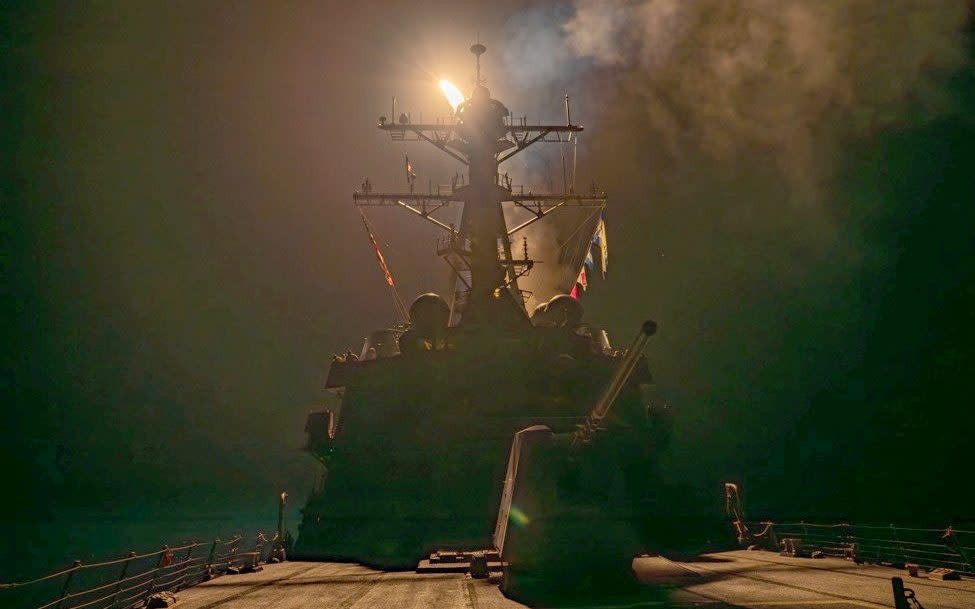The US Navy is in the thick of the Red Sea fight. But there’s one warship class that’s missing

The US Navy has surged warships into the Middle East in response to the growing threat that Yemen’s Houthi rebels pose to commercial shipping passing through regional waters.
But there’s one ship type the American fleet isn’t surging into the region. The troubled Littoral Combat Ship. Farcically, the LCS is one of the more numerous ship types in the fleet. But it’s totally unsuitable for hard fighting. And the fighting around Yemen has been very hard.
That the US Navy has left behind its 26 LCSs is the latest humiliation for military leaders who advocated for the ship during its long development – and the latest reminder that the American fleet is, in practice, much smaller than it appears to be on paper.
If the LCSs can’t fight the Houthis, who can they fight? That likely answer is: no one. The US-led naval campaign in the Red Sea, Gulf of Aden and the Persian Gulf gradually took shape in the weeks after Hamas terrorists raided southern Israel and killed or kidnapped hundreds of people.
While Israeli forces mobilised for their brutal invasion of Gaza, American and allied warships steamed into the waters around Israel in the hope of preventing a wider regional escalation. Deterrence failed, however: Iran-backed Houthi militants based in Yemen began boarding and bombarding commercial ships taking the global shortcut through the Suez Canal.
In their first major attack, on Nov. 19, Houthi fighters riding in a helicopter seized the 48,000-ton car-carrier M/V Galaxy Leader, taking all 25 crew hostage. Over the next two months, Houthis took aim at another 41 commercial ships with drones, rockets, missiles and boarding teams.
The threat has compelled shippers to divert much of their trade away from the Middle East. To avoid Yemeni waters, a commercial vessel traveling between the Atlantic and Pacific Oceans cannot pass through the Suez Canal. Instead, it must sail around South Africa – adding 4,000 miles and great expense to its trip.
An American-led fleet is trying to contain the crisis. It’s a powerful force organised around the aircraft carrier USS Dwight D. Eisenhower and reinforced by eight other large American warships: four destroyers, two amphibious assault ships, a cruiser and a cruise-missile-armed submarine.
Allied forces have shot down around 20 Houthi ballistic and cruise missiles and around 80 drones and destroyed three Houthis boats. And in a series of air strikes and cruise-missile raids beginning on Jan. 11, these same forces have targeted dozens of Houthi missile launch sites and a radar installation.
Despite representing a fifth of the US surface combatant fleet, which also includes the destroyers and cruisers, no LCSs have joined the campaign. It’s not hard to understand why. The LCS program originated in the 1990s and began spending real money, and building ships, in the early 2000s – an era where land warfare dominated Pentagon planning. The idea was to equip the US fleet with 50 or more vessels that could sail fast in shallow, near-shore littorals. To keep them small, their weaponry would be light.
The Pentagon’s $37-billion commitment to the LCS was a profound misreading of the future security environment. With no long-range air-defenses, the 3,000-ton LCSs can’t protect themselves from the Houthis’ Iranian-made missiles and drones – to say nothing of protecting commercial ships that might be spread out across thousands of square miles.
And with no long-range land-attack weapons, the LCSs can’t strike back at the Houthis, either. If the LCSs are unsuitable for defense and offense against a regional militant group, how would they fare against a much bigger and more sophisticated foe like China?
Not well. The LCSs suffer a “lack of sufficient warfighting capability against a peer competitor in China,” Adm. Mike Gilday, then the Chief of Naval Operations, told US Senators two years ago, as he sought permission to retire half of the 38 planned LCSs – despite many of them being brand-new.
So far, the US Congress has permitted the US Navy to decommission nine LCSs. The fleet is scrambling to upgrade many of the remaining 29 vessels in order to make them relevant in a world where even militant groups have missiles and drones.
Some of the LCSs are getting long-range anti-ship missiles that, in a pinch, might work against targets on land. The US Navy is also experimenting with long-range anti-air missiles that, bolted to an LCS’s helicopter pad, could give the ship some ability to protect itself and nearby ships.
But these are half-measures that might lend a few ships a fraction of the firepower that a destroyer possesses. The Houthis didn’t target Middle East shipping to prove that the American fleet’s shallow-water surface combatants were hollow ships. But their attacks have had that effect.
For as long as the US Navy hangs onto its LCSs, the ships will mostly be dead weight: naval tonnage that contributes little or nothing to an actual war.

